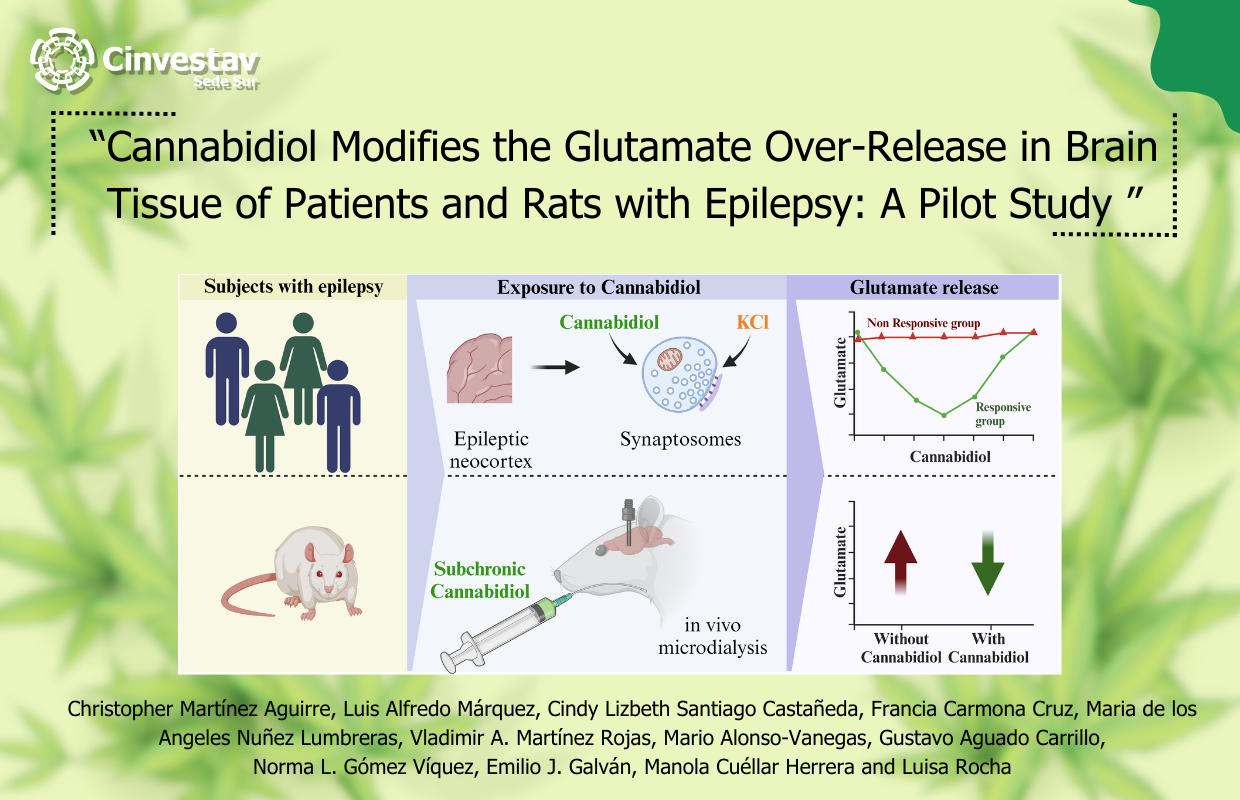Luisa Rocha- Cannabidiol Modifies the Glutamate Over-Release in Brain Tissue of Patients and Rats with Epilepsy: A Pilot Study

7 de diciembre del 2023
Invitamos a leer el artículo: " Cannabidiol Modifies the Glutamate Over-Release in Brain Tissue of Patients and Rats with Epilepsy: A Pilot Study ", realizado por la Dra. Luisa Rocha, Investigadora de Cinvestav Sede Sur
Autores: Christopher Martínez Aguirre, Luis Alfredo Márquez, Cindy Lizbeth Santiago Castañeda, Francia Carmona Cruz, Maria de los Angeles Nuñez Lumbreras, Vladimir A. Martínez Rojas, Mario Alonso Vanegas, Gustavo Aguado Carrillo, Norma L. Gómez Víquez, Emilio J. Galván, Manola Cuéllar Herrera, Luisa Rocha
Abstract: Drug-resistant epilepsy (DRE) is associated with high extracellular levels of glutamate. Studies support the idea that cannabidiol (CBD) decreases glutamate over-release. This study focused on investigating whether CBD reduces the evoked glutamate release in cortical synaptic terminals obtained from patients with DRE as well as in a preclinical model of epilepsy. Synaptic terminals (synaptosomes) were obtained from the epileptic neocortex of patients with drug-resistant temporal lobe epilepsy (DR-TLE, n = 10) or drug-resistant extratemporal lobe epilepsy (DR-ETLE, n = 10) submitted to epilepsy surgery. Synaptosomes highly purified by Percoll-sucrose density gradient were characterized by confocal microscopy and Western blot. Synaptosomes were used to estimate the high KCl (33 mM)-evoked glutamate release in the presence of CBD at different concentrations. Our results revealed responsive tissue obtained from seven patients with DR-TLE and seven patients with DR-ETLE. Responsive tissue showed lower glutamate release (p < 0.05) when incubated with CBD at low concentrations (less than 100 µM) but not at higher concentrations. Tissue that was non-responsive to CBD (DR-TLE, n = 3 and DR-ELTE, n = 3) showed high glutamate release despite CBD exposure at different concentrations. Simultaneously, a block of the human epileptic neocortex was used to determine its viability through whole-cell and extracellular electrophysiological recordings. The electrophysiological evaluations supported that the responsive and non-responsive human epileptic neocortices used in the present study exhibited proper neuronal viability and stability to acquire electrophysiological responses. We also investigated whether the subchronic administration of CBD could reduce glutamate over-release in a preclinical model of temporal lobe epilepsy. Administration of CBD (200 mg/kg, p.o. every 24 h for 7 days) to rats with lithium-pilocarpine-evoked spontaneous recurrent seizures reduced glutamate over-release in the hippocampus. The present study revealed that acute exposure to low concentrations of CBD can reduce the glutamate over-release in synaptic terminals obtained from some patients with DRE. This effect is also evident when applied subchronically in rats with spontaneous recurrent seizures. An important finding was the identification of a group of patients that were non-responsive to CBD effects. Future studies are essential to identify biomarkers of responsiveness to CBD to control DRE.
Keywords: cannabidiol; glutamate; dual effects; drug-resistant epilepsy; temporal lobe epilepsy; extratemporal lobe epilepsy